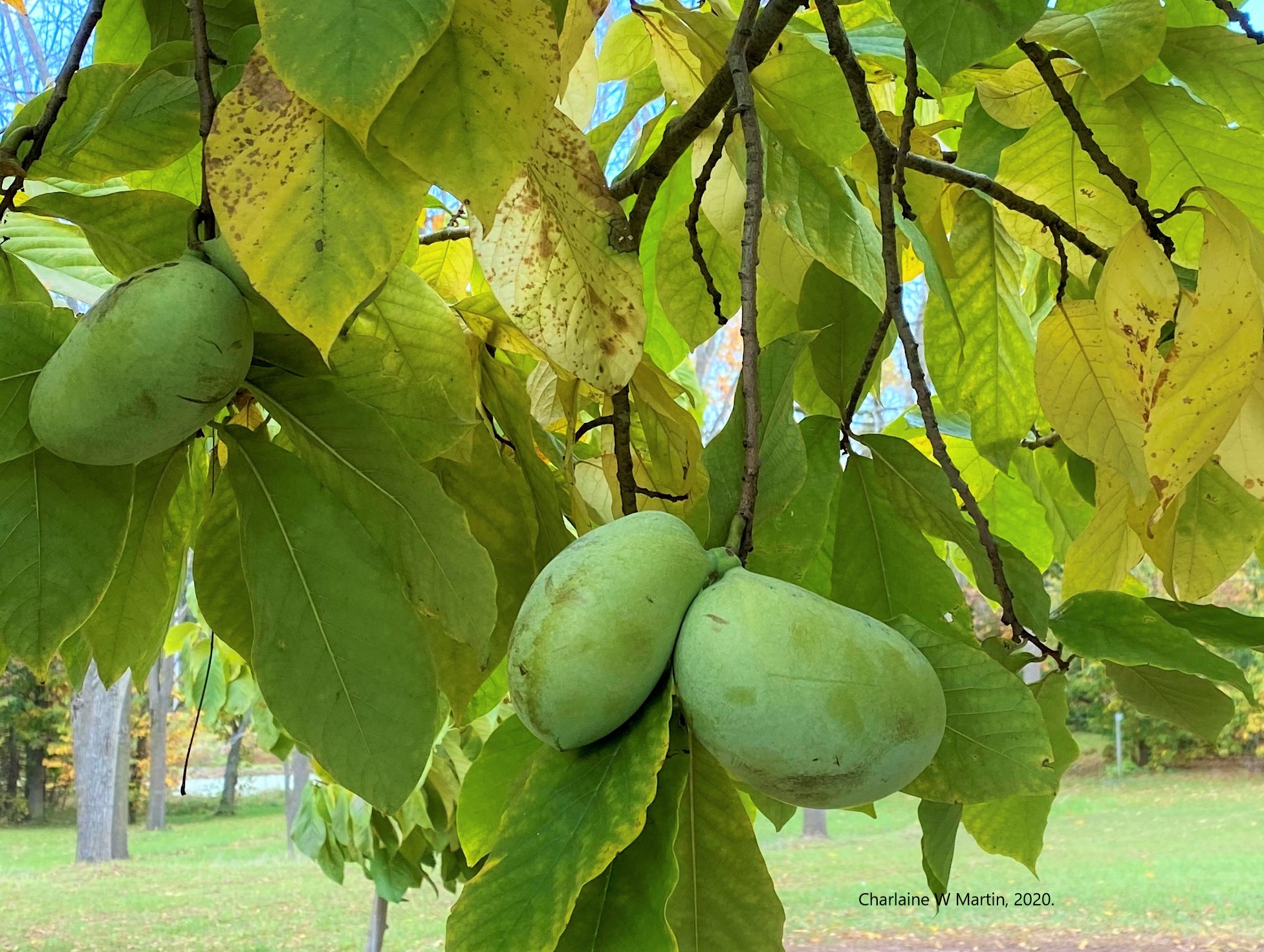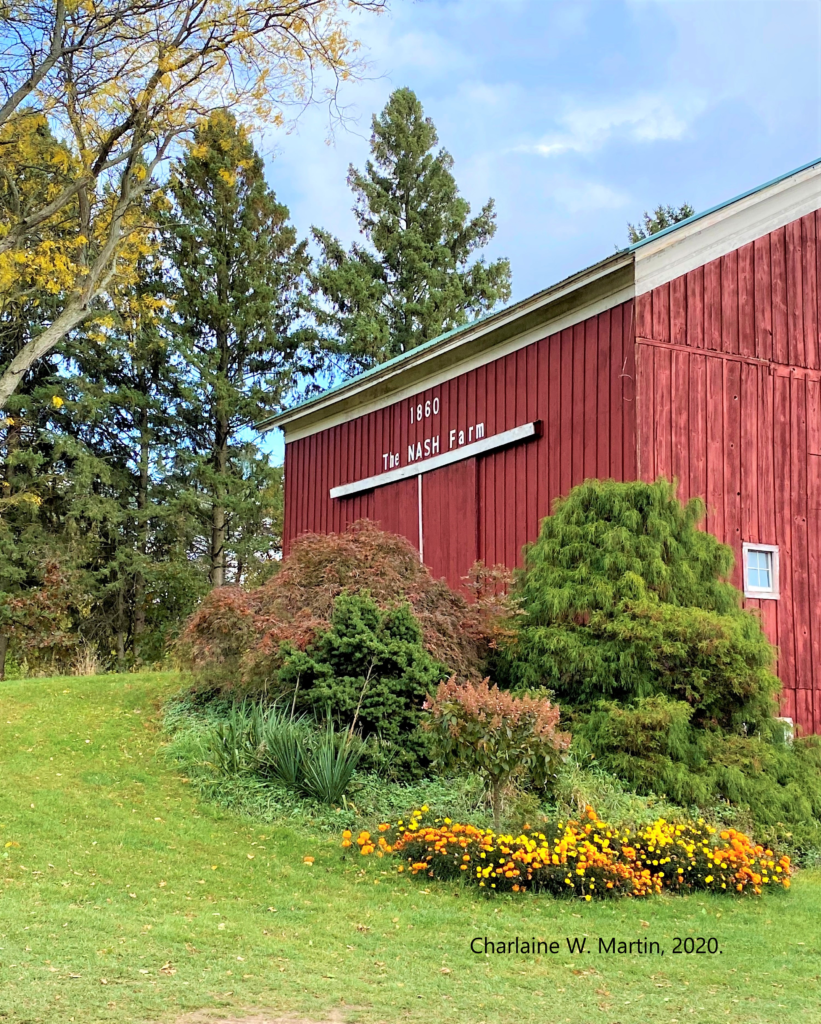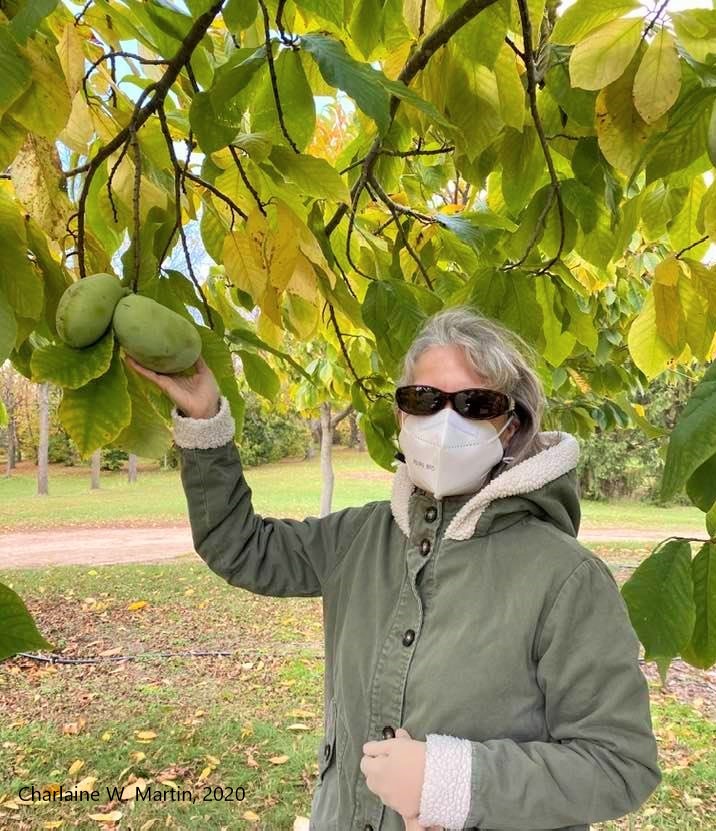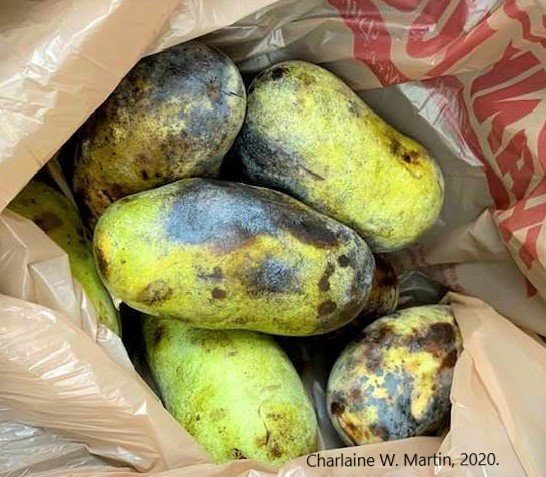Going on a PawPaw Hunt

My husband’s childhood favorite fruit was Pawpaws, a common fruit in the wild where he and his father hunted in Tennessee and Indiana. He told me he would love to grow them in our yard. I remember reading about them in a couple of stories I read as a little girl and singing an Appalachian song, Way Down Yonder in the Pawpaw Patch, in music class. I never experienced this forgotten American treasure my husband loved.
Intrigued by what I read about them in a Google search, I’ve tried to find them the past couple of years. I found out where we could purchase these trees for our yard, but I wanted to experience one first. Everywhere I looked for these tasty delights, I’d have to pay an exorbitant price to order some online. So, Boaz and I drove to PawPaw, Michigan, one afternoon where he remembered seeing some. There must be pawpaws, hence the town name. The tree was still there with a couple of immature fruit hanging high upon this unique tree. His Dad used to give him a boost to climb up the tree and either pick some or shake them from a branch. First, being mid-lifers with arthritis, climbing up high in any tree was not my idea of a great time. Second, I wondered if we should even pick the fruit in front of the municipal building. Disappointed, we drove back home.
This year I prayed to find a Pawpaw on one of our nature walks while taking in the beautiful fall foliage display. “Just one, Lord,” I pleaded, “I would like to try one.” Zilch. Sighing with disappointment, we left the park empty-handed. The gorgeous scenery didn’t disappoint us, though. We discussed my prayer on the way home and started Googling, where we might find PawPaws near us. After about a week, my Boaz proudly announced that he found a place an hour and a half away at a large family-run nursery where they also sold the trees.

We pulled into the parking lot of Nash Nurseries in Owosso, Michigan, one chilly afternoon. They indeed had this elusive fruit for sale. At the counter, the kind gentleman opened up a cooler case, pulling a tray of them out for us to choose the ones we wanted. They looked odd, but the aroma tantalized our tastebuds. He also took us on a tour of the orchard with his golf cart a long way to the back acreage proudly showing us these unassuming trees. The beautiful trees had green clusters of fruit amid the yellow adorning large, downward dangling leaves. We were convinced we’d love to purchase a couple of trees in the future to grow our own.
We couldn’t wait to taste our prize, the only native fruit in Michigan when we arrived home. Inside the odd-looking black splotched green skin was a yellow creamy pulp. We squeezed it, sucking it out of our halves, or scoop out with a spoon, if we wanted to be tidier about it. This variety tasted a bit like a blend of vanilla custard and banana. I could imagine it would taste like vanilla ice cream when frozen. Other varieties taste more like a blend of mango and banana. This treat was worth the trip, but it certainly topped our list of trees to plant in the future for a late fall harvest.

What are PawPaws?
Pawpaws are a native fruit to North America, enjoyed by humans and animals since before the Ice Age. Lewis and Clark survived by eating them solely for twelve days on their expedition. Thomas Jefferson grew them at Monticello. It was George Washington’s favorite dessert. (Wikipedia, Owens Native Foods). Unfortunately, it isn’t as popular today. After all, they can’t easily be shipped to stores green because they won’t ripen when picked too early, according to the gentleman at Nash. Their harvest time is between mid-September to mid-October. They bruise, ripen, and rot quickly, so you pick them when you see them ready. Eat them quickly or freeze them to extend the time you can enjoy them. You can use them in place of bananas in baking, make into ice cream, and preserve through canning. No wonder they are a bit pricey to purchase!
Nutritional Value of the “Michigan Banana”
This delightful fruit is very nutritious, earning the title “Super Fruit.” The pawpaw is packed with nutritional value, containing Vitamin C, vitamin A, thiamine, niacin and riboflavin, potassium, manganese, iron, magnesium, and copper. According to Owen Native Foods, “Pawpaw fruits vary in size, usually ranging from 5 ounces to a pound each. A 100-gram serving, or about 3.5 ounces, of pawpaw fruit, provides 80 calories, 1.2 grams of each protein and fat, and 18.8 grams of carbohydrates, including 2.6 grams of fiber, or 10 percent of the daily value. Fiber helps fill you up on fewer calories and may lower your risk for heart disease, constipation, and Type 2 diabetes.” Fiber also helps prevent atherosclerosis and colon cancer. Delicious and nutritious. What a combination!

What About Elusive Fruit?
Read: Galatians 5:16-25 NKJV
Focus Verse: But the fruit of the Spirit is love, joy, peace, longsuffering, kindness, goodness, faithfulness, gentleness, self-control. Against such there is no law. Galatians 5:22-23 NKJV
In many ways, the rarity of the pawpaw in our day makes me think of the Fruit of the Spirit from Galatians 5. All of them are available to us as believers. Still, specific issues in our lives make the availability of particular spiritual fruit difficult to obtain. The people Paul addresses in his letter to the Galatian church aren’t much different than Christians today, living in a diverse secular environment. He strikes a contrast between the fruit of sinful living and the fruit of the Spirit. They could not have both. To attain all the spiritual fruit of love, joy, peace, patience, gentleness, kindness, and self-control, they had to give up the flesh’s lust by allowing the Holy Spirit control of their lives. Only then could they have this spiritual fruit, and share it with others through their behavior.
Some spiritual fruit can elude us, too. We may experience some fruit, but some of our own issues are contrary to the particular spiritual fruit we wish to display. Patience, also known as longsuffering, is one that I long for but only experience once in a while. In fact, when I consider pawpaws, I think of patience because the pawpaw tree is very resilient, with few natural threats to its existence. Because Fall is the season to harvest this fruit, it seems that Christians develop patience over time, finally obtaining it in later life. Patience makes us much more resilient to the disease and pestilence of hostility, quarreling, jealousy, outbursts of anger, selfish ambition, dissension, and division (NLT). We find it when we seek it out through prayerful time with God. The Holy Spirit convicts of those sin issues rotting in our hearts that we might let go of it to receive the spiritual fruit we long for.
Only when we let go of specific sin issues in our lives can we reach out to God for all of the spiritual fruit he wants us to experience in our daily lives. Confessing our sin issues to God then repenting– turning away from that sin– is necessary to obtain all of the fruit of the Spirit. Let us reach up to God to receive the Fruit of the Spirit by letting go of what is not from him.
Prayer: Lord, I am sorry that I bring rotten fruit with me into your orchard. I give it to you that I might receive the goodness of all the Fruit of the Spirit you have for me. Work in me that I will share it with everyone I meet, a testimony of your love. Amen.
Resources:
The Holy Bible, New King James Version ®. Copyright © 1982 by Thomas Nelson.
https://www.nashnurseries.com/pawpaws.html
https://www.livestrong.com/article/329114-paw-paw-tree-fruit-nutrition/
https://owennativefoods.com/pawpaw-2/paw-paw-history/
https://en.wikipedia.org/wiki/Asimina_triloba
